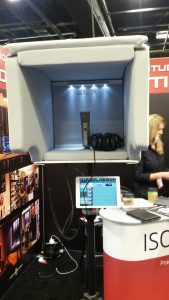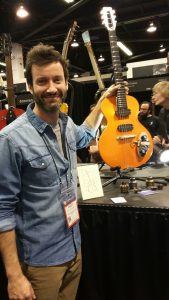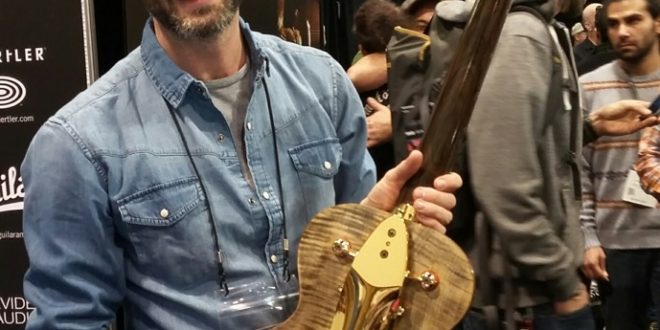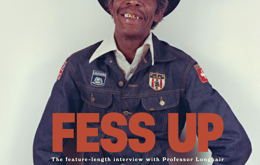Have you ever been seized by the urge to burst into song at three a.m. but repressed it, fearing angry howls from slumbering neighbors? Philip Olsson feels your pain. He shares it. Repression drove him to create one of the more interesting innovations at the 2017 NAMM Show. “In the capital city of Sweden, Stockholm, everyone lives in apartments,” Philip explains. “I had a really annoying neighbor. He got disturbed by everything. He was home all day, all night, and just waited to complain when I’d make some noise. It was impossible to develop as a musician and as a vocalist without practicing. So I got in my car, drove a few miles, and just sang—it was the only way! But it wasn’t very effective, and it cost a lot of money to drive around, just to practice. I searched the Internet for something to solve my problem, but I didn’t find anything. Then I realized that there must be many more like me who need a solution for this problem. So that’s when the idea struck me, and that’s when the process began.”
Nearly five years later, Philip brings his Isovox2 to the world’s biggest music biz trade show, where thousands gawk and hawk, mingle and make deals. The corporate giants arrive in battalions (some, like Yamaha, encamp in their own separate halls), but individuals eager to market a `better mousetrap’ come from the far corners of the globe to the Anaheim Convention Center each January, renting modest booth space and hoping to draw interest.
This is Philip’s first NAMM, a journey encouraged by his invention’s positive reception in Europe. “In 2016, when we launched the product, we got customers from over fifteen countries,” he says. “Now we’re trying hard to expand and move across borders.” Back in the land of IKEA with its tradition of creative design, Philip won an award for innovation.
So what is this new Swedish wonder, the Isovox2? In simplest terms it’s a box on a stand with a microphone inside. (The demo model at NAMM has a computer recorder and headphones, too.) It’s enclosed on three sides. For optimal isolation you can pull a flap down behind you once you’ve stepped into it. Inside there’s a shelf (or, since it’s a box, you might say floor) through which the mike stands. You can put lyrics (or your phone) on the shelf. The `wall’ you face offers soft lights. It feels cozy in there.
What’s the point? Well, aside from a quiet rehearsal space for apartment dwelling singers, it’s a portable vocal studio offering an acoustically consistent studio space. A touring singer wishing to lay down vocal tracks could use it any place or time and not fear the vagaries of ever-changing acoustic spaces. “This new Isovox2 is 100% portable,” says Philip. “You can put it in a bag, pack it as flat baggage or stuff it under your bed.” Singers aren’t the only potential users: anyone doing audio vocals outside a studio for any purpose, such as radio announcing or voiceovers, would welcome a box-sized portable studio that offered consistently focused sound. Philip says getting the acoustics just right was his biggest challenge. Isovox2 is not just a box: there’s carefully designed insulation aimed at delivering dry sound that’s not muffled. “The sound isn’t totally dead, it gives a little bit of reflection,” he says. Philip’s box went through lots of R&D before it got to NAMM. He can thank that cranky neighbor for the motivation.

For San Francisco-based guitar maker Nick Pourfard, his motivation came from a nasty spill. “I was skating when I was eighteen and I hurt my ankle,” says Nick. “I was already experimenting with woodworking, building furniture and all this other stuff. I got to the point where I wanted to build my own guitar. I already played. I didn’t want to make a guitar I could buy in a store, right? I wanted to make something special, sentimental to me. So I came up with the idea of making guitars from skateboards.”
OK, that sounds like a gimmick, but Nick says, “Skateboards are hard rock maple, just like a guitar neck.” Nick’s guitars vary in the range of their recycled skateboard content: some are more skate motif than material, while others may be 100% board except for a rosewood fingerboard. Nick’s into it: describing one guitar, he says, “This is quarter sawn skateboards, it’s like 20 skateboards cut through.” Obsessive? You bet. Nick’s a details guy; every nuance of his Prisma Guitars is customized to his specs. “That’s a Strat pickup and that’s a humbucker,” he says of one of his axes, “but they’re housed in P-90 casings. I think it’s cool to do that. It opens the possibilities for the realm of both sound and aesthetic.” Who says skateheads aren’t artists, too?
https://www.prismaguitars.com/
The guitar as art is the point of NAMM’s Boutique Guitar Showcase, spotlighting creative luthiers from across the globe. Enrico Di Donato brought his stunning electric guitars from Venice, Italy. Last year they turned heads at Berlin’s Holy Grail Guitar Show. Enrico’s adventurous approach to guitars surely owes something to his apprenticeship to a brother who builds violins, violas and cellos. In 2010 Enrico struck out on his own to make electric guitars. “I’m experimenting, obviously, always changing,” he says. “You can change the material of the body, of the neck and the bridge. If you change the material of the bridge you change completely all the sound and the response of the guitar. The bridge is one piece of metal that’s fixed without any screw or any saddle. The only thing that touches the body is the bridge.” That’s a radical design. Enrico says, “There is an aluminum frame, it’s the stiff part of the guitar, and the body is the soundboard. It’s completely suspended. It touches only four points. The position of the four points makes sense for the vibration of the guitar. Also the neck is detached from the body.” This floating body design leads Enrico to say, “This is an electric guitar, but it has a lot of acoustics also.” He invites me to touch the top as he strums the strings to demonstrate his point, and I feel the thin solid body vibrating in the manner of an acoustic guitar top. Here’s a melding of science, craft and art in one sleek and elegant performance package. If it reminds you a little of the best designed European sports cars, it’s no accident: the finish, says Enrico, is the same paint used by Lamborghini.
http://www.didonatoguitars.it/
 Not everyone gets it right. If there were a Worst of Show prize at NAMM, it might go to C.F. Martin & Co. for its proudly displayed `two millionth Martin guitar.’ What possessed Martin to partner with watchmaker RGM to transmogrify a D-45 into an ugly gewgaw? A clue is offered by C.F. Martin IV in a press release testimonial: “The two millionth guitar is complicated, particularly because it incorporates an actual watch into the design,” he writes. “But once you’re excited, you sort of put aside the hurdles that you have to jump over. RGM was a perfect fit because they’re in Pennsylvania and still make fine handcrafted watches in Pennsylvania.” Penn State pride aside, the defacing of a dreadnaught with multiple toothed gears looks like a stoned epiphany brought to awful fruition. It also suggests a total misreading by Martin of Martin’s brand: much of its appeal has always been clean unadorned lines, the quality of the instrument being its seller, not superfluous visual flash.
Not everyone gets it right. If there were a Worst of Show prize at NAMM, it might go to C.F. Martin & Co. for its proudly displayed `two millionth Martin guitar.’ What possessed Martin to partner with watchmaker RGM to transmogrify a D-45 into an ugly gewgaw? A clue is offered by C.F. Martin IV in a press release testimonial: “The two millionth guitar is complicated, particularly because it incorporates an actual watch into the design,” he writes. “But once you’re excited, you sort of put aside the hurdles that you have to jump over. RGM was a perfect fit because they’re in Pennsylvania and still make fine handcrafted watches in Pennsylvania.” Penn State pride aside, the defacing of a dreadnaught with multiple toothed gears looks like a stoned epiphany brought to awful fruition. It also suggests a total misreading by Martin of Martin’s brand: much of its appeal has always been clean unadorned lines, the quality of the instrument being its seller, not superfluous visual flash.
https://www.martinguitar.com/guitars/2-millionth-guitar/
Speaking of visuals, it looks something like a mushroom, but that’s not a selling point for Poland’s Zylia Portable Recording Studio, another NAMM `17 newbie. Designed by audio engineers, it boasts a `state-of-the-art microphone array’ (19 in all!) that allows for multi-directional recording and the ability to isolate and mix those strings behind you with those horns in front of you as if they were separately recorded tracks. This is an innovation with great potential, especially for making quality `live’ recordings without having to set up multiple microphones.
Since he was nice enough to offer samples, I’d like to thank Brian Ault of Gravity Guitar Picks, which aren’t your run-of-the mill guitar picks: “We laser cut out the basic shape of the pick from sheets of acrylic and from there we grind the shape of the pick on a grinding wheel,” says Brian. “We polish it from there and then it goes back into the laser engraver and we laser engrave the graphic logo on top.” And the picks look like they may glow in the dark!
I should also mention my favorite NAMM vendor name, Iga Dada, whose distortion pedals boast a fierce Garuda logo. Jakarta is a long way from Anaheim, and his company was the sole representative of Indonesia this year.
NAMM is a big noisy marketplace, and noise has always gone hand in hand with hawking wares. But the competitive cacophony at NAMM—distorted electric guitars vs. drum kits vs. audio systems—has reached a point where a day there is a test of nerve and endurance. NAMM could do some discreet decibel policing to insure the din remains below the threshold of pain. I feel for the Convention Center staff, some of them seniors, who have to endure a full three and a half days of that. After just a few hours I yearned to have my head closeted snug in a quiet Isovox2, insulated from a world of inchoate aggressive noise.
 Baja Review A community newspaper serving Ensenada, Valle de Guadalupe, and Rosarito in Northern Baja California
Baja Review A community newspaper serving Ensenada, Valle de Guadalupe, and Rosarito in Northern Baja California





